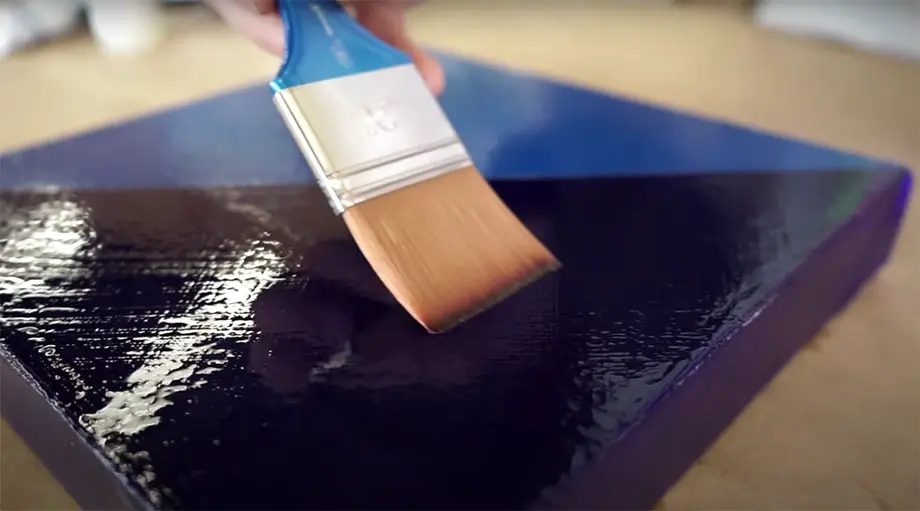Creating art – for fun, sales, or as part of your cherished memories- is incredible. However, letting that artistic masterpiece languish unprotected from the ravages of time isn’t just sad but also unnecessary. Acrylic paintings require extra special care. If you don’t properly look after them, they risk being damaged. Let us show you how to protect acrylic paintings on canvas.
If you want your beautiful acrylic painting to stand the test of time, more than just varnishing needs to be done. Check out these five steps for maximum protection and ensure long-lasting preservation. From priming the canvas and using an isolation coat to UV-protected framing – all topped off with some TLC maintenance. This process will ensure that you can protect the acrylic painting and that it remains a timeless treasure.
Four Reasons Why You Need to Protect Acrylic Paintings
When it comes to our masterpieces, we can ensure their lasting protection without spending a fortune. By taking simple steps now, we can guarantee that future generations will enjoy these creations or have the potential for monetary value.
Acrylic paint is the perfect medium to express yourself, for professional artists to complete beginners. Even if you learned oil painting, don’t be afraid of branching out into the world of acrylics with excellent results. With fast drying times and various properties, you’ll never be stuck for ideas regarding acrylic painting on canvas.
Here are four reasons why you need to protect acrylic paintings:
Keep your acrylic painting dust-free
If you’re an acrylic painter, keeping your artwork clean and pristine is the ultimate dilemma. The acrylic paint can easily collect dirt. This is why a protective finish like varnish seals up surfaces. You can seal acrylic paint and make it easier to clean- forget the hassle of scrubbing off unprotected paint.
Get a perfect and smooth surface with protective finishes. These help your character look smooth and even and provide vital cleaning and protection—no more bumps or textures – just flawless surfaces for you to admire.
Make cleaning easier
You can keep those precious acrylics looking new with just a soft duster. Don’t worry – they won’t fade or smudge if exposed to water, with a protective finish keeping them safe.
Preserve color saturation and protect acrylic paint for years
Protecting your acrylic painting isn’t just about ensuring its longevity. It’s also the key to keeping those vibrant colors alive. With a protective finish, you can guarantee long-lasting color saturation and even add a glossy finish for maximum impact.
Protect paintings from UV rays, extreme temperatures, air circulation, and moisture.
Do you want to save your acrylic paintings from warping, cracking, and peeling due to changes in humidity and temperature? Do you want to avoid the vibrant colors fading away due to UV rays? It would be best if you sealed an acrylic painting for that.

How to Preserve Acrylic Paint on Canvas? – Five-Step Process
Keep your acrylic artwork safe and sound by following these tips.
1. Prime canvas to safeguard your artwork
Painting on an empty canvas can be intimidating for beginners, but you don’t have to start from scratch. Picking up a pre-primed white or black canvas is the easiest way to get your creative juices flowing.
Raw canvas can be tricky to work with, but luckily you have an ace in the hole – gesso. This primer is designed specifically for natural canvas and will help ensure a successful painting experience whenever applied across multiple thin layers. This great barrier between paint and canvas helps keep your masterpieces looking vibrant without absorbing the color.
2. Before you varnish your painting, apply an isolation coat.
You’ve completed your masterpiece, but don’t rest on your laurels. Please ensure to apply an isolation coat to the surface. It’ll help protect all that hard work from dust, dirt, or other pesky contaminants. Besides, watching the finished painting when removing varnish is crucial to avoid accidentally damaging it.
Art supplies stores are a great place to look for isolation coats. For an effective protective layer, selecting a top-notch isolation coat is essential. The Golden Artist Colors Isolation Coat is ideal for protecting and unifying every masterpiece under one layer of varnish.
3. Protect your painting with a UV-resistant varnish
You can protect canvas paintings with UV-resistant varnish for a lasting impact. You can select from glossy and matte varnish according to your image, making it stunning.
You can apply an acrylic resin varnish for a non-yellowing glossy finish. With just a few thin, even coats and drying in between, it’ll be ready for storing or displaying.
4. Keep it in a cool and dry environment, away from direct sunlight.
If you want your varnished painting to look fresh and new, ensure it’s stored in a cool place away from direct sunlight. Keep those vibrant colors alive for years by keeping the painting in rooms away from direct sunlight. Humidity and temperature changes can cause severe damage over time, so it’s essential to consider an area with low humidity levels.
5. Wipe with mild soap and water or a soft cloth every few months.
Making sure your paintings stay fresh and fabulous got easier. Just be careful not to use harsh chemicals or abrasive cleaners that can cause irreparable damage. A soft cloth with a mild soap and water mixture will do the trick. With these simple steps, you’ll ensure your beautiful artwork remains breathtaking for years.
How to Varnish an Acrylic Painting?
You can revive and refresh your artwork with a simple varnish. With just one coat of varnish, you’ll see an increase in color saturation, making it look freshly finished. You can quickly eliminate all the yellowing and dust built over time by removing and replacing varnish.
Brush application is great for smooth surfaces. However, you can consider spraying varnishes for surfaces with texture. We recommend Grumbacher spray varnish for this. If you select permanent varnish, be aware that it cannot be removed and may become yellowed or dusty over time.
When reserving your artwork, opt for a no-fuss approach and choose Golden Polymer removable varnish. Now let’s begin with the varnishing process.
For this project, you’ll need an empty container, the varnish of your preference, and a broad and flat brush to apply varnish.
- Before beginning, apply an isolation coating that takes 1-2 days to dry.
- To ensure you have the best results, start by cleaning the surface. Then wipe it with a lint-free cloth.
- Ensure that your workspace is adequately prepped. You will need a large and flat brush – it’s best to use one you don’t typically utilize for painting. Consider if thinning the varnish might be recommended by the manufacturer. Additionally, bring in a clean container and ensure adequate materials by adding a bit of extra varnish.
- Ensure the painting is placed horizontally on a dust-free and flat surface for optimal preservation.
- Apply the initial varnish coat swiftly and with a light touch. Begin from the top and brush in even strokes down to the bottom before switching sides. Be sure to avoid revisiting sections that have not yet dried.
- Allow the painted surface to dry for 24 hours before applying up to three coats. Then, observe it from different angles to ensure no portions are left uncovered.
Protective finishes
For years, artists have sought ways to protect their paintings; but times are changing. While varnish was once the go-to material for sealing oil paintings and bringing out their vivid colors, some modern artists find it outdated.
But why? It turns out that traditional varnishes contain solvents, oils, and alkyd resin to seal an acrylic painting. Working with varnish can be pretty tricky. It tends to become cloudy when dried and must be immediately removed, as it will yellow over time, making even seasoned pros wary.
To ensure your acrylic work of art stands up to the test of time, you need a self-leveling finish that’s non-yellowing, water-based, and provides an eye-catching gloss. Minwax Protective Finish is the perfect alternative to traditional varnish.
How to Protect Acrylic Painting – Types Of Acrylic Varnishes
Keep reading to find the various finishes, types, and formulations of varnishes available.
Acrylic Resin Varnish And Polymer Varnish
Are you craving an ultra-glossy, vibrant finish for your acrylic paints? You might want to consider resin. This glossy varnish protects your painting from dullness and scratches. But beware: it comes with a few extra challenges- from higher prices and longer drying times to health safety concerns like high fumes and skin irritants. Hence, you need to ensure safety.
Acrylic polymer varnish is most commonly used to seal acrylic paint. You may want to try a polymer-based varnish if you are trying to achieve that glossy, show-stopping finish. Also, you don’t have those pesky resin fumes, as acrylic polymer varnishes are safer than acrylic resin varnish.
Non-Permanent and Permanent Varnish
Non-permanent varnish can be visually appealing, but it’s not the most reliable option for long-term protection. On the other hand, the permanent one offers a more durable shield against dust, dirt, and sunlight.
Spray Varnish and Brush-On Varnish
Spray-on varnish is the easiest of them all. It’s excellent for covering large areas quickly, although you may not have as much control over the application. When you want to seal an acrylic painting that’s large or multiple smaller ones all at once, using a spray-on sealer is ideal. It can also be beneficial when the surface cannot be laid flat horizontally.
Brush-on sealer is an excellent option if you’re looking to avoid heavy fumes. Brush-on varnish is more laborious but provides greater control for achieving that perfect finish. However, applying it can be more challenging, resulting in an uneven surface with visible brush strokes.
Glossy varnish, Satin varnish, and Matte varnish
Applying a high gloss varnish to your painting will bring out the colors with its reflective finish, making it truly shine.
A satin or matte finish might be the perfect fit if you’re looking for a more subtle, matte look. While these options can potentially lighten the colors of your paint job, it’s one factor to consider. With this in mind, you’ll have no problem achieving that perfectly polished appearance on any surface.
Conclusion
If you are wondering how to protect acrylic paintings on canvas, there is no one-size-fits-all solution. You can find the perfect finish that matches your needs with the many varnish types available. Consider the glossiness, permanence, and other factors before selecting a formula. And don’t forget to allow for proper drying time! After all, when protecting your artwork, you don’t want to leave any stone unturned.












Leave a Reply